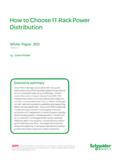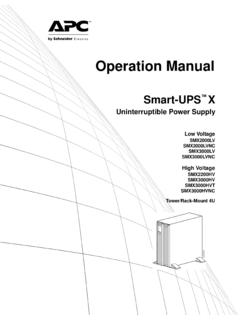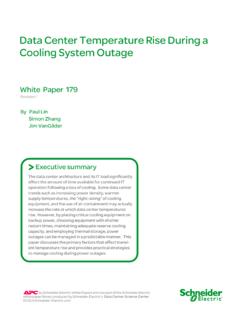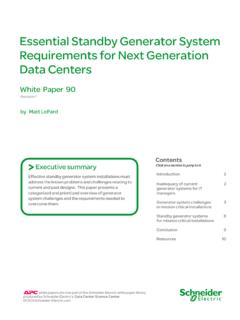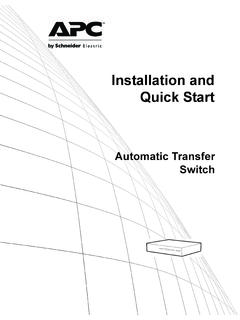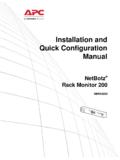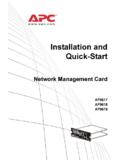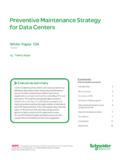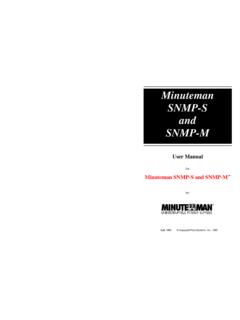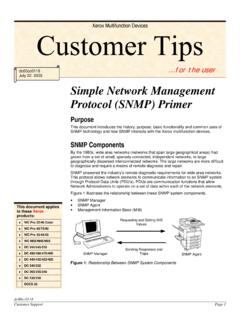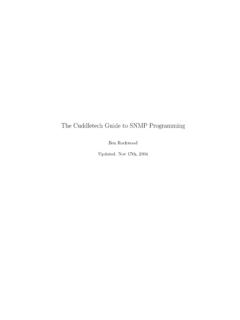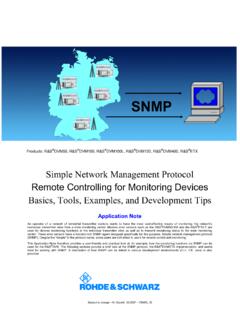Transcription of SNMP Monitoring for Smart-UPS - SNMP Metrics Catalog
1 KaseyaN-centralAVGNPMT hresholdPolling FrequencyDescriptionSNMP Data Type upsBasicIdentModel**NAInitial DiscoveryUPS model name, 'APC Smart-UPS 600'.Display String upsAdvIdentFirmwareRevision**-NADailyThe firmware revision of the UPS system's String upsAdvIdentDateOfManufacture**NAInitial Discovery, WeeklyThe date when the UPS was manufactured in mm/dd/yy (or yyyy) String upsAdvIdentSerialNumber**NAInitial DiscoveryA string of characters identifying the serial number of the UPS in Smart-UPS . Display StringupsAdvIdentSkuNumber**NAInitial DiscoveryThe SKU Number of a UPS String upsAdvBatteryInternalSKU(*)(*)(*)(*)NAIn itial DiscoveryInternal Battery SKU. Not present in all UPS models. Display String upsAdvBatteryExternalSKU(*)(*)(*)(*)NAIn itial DiscoveryExternal Battery SKU.
2 External batteries not supported in all UPS models. Smart-UPS allow for a maximum of ten additional battery packs. Display StringAbout Policy (Static information except for Firmware Revision)UPSD evice Monitoring - snmp Polls (GETs) snmp Monitoring for smart -UPSSNMP Metrics Catalogue, ref: PowerNet MIB, UPS MIB RFC-1628 Notes: 1. This Metric Catalogue describes the key OID Metrics that are provided in Monitor Kit Integration sets for selected RMM Administrators can enable or disable the OIDs to suit their particular installationand Monitoring needs. 2. If an Integration Kit or manufacturer-built policies are not provided, IT administrators can build and deploy their own snmp based Monitoring policies depending on the capabilities of their Remote Monitoring andManagement tool.
3 Please refer to Application Note [AN-195] for more information. 3. Most installations take an iterative approach in deploying remote network Monitoring , to balance the amount of collected information with the operational procedures in place to process it. Data points that areimportant to monitor include but are not limited to UPS Status (online/on battery), Battery Runtime Remaining, Battery Temperature, Battery needs replacement, Low Battery and Overload. Temperature and load values can also be monitored for sudden changes even if changes are within permitted range. 4. SNMPP olling: Remote Monitoring and Management (RMM) tools use network polling to retrieve static and dynamicdata from the snmp enabled devices on the network. To increase efficiency, administrators cancreate alert rule configurations on the RMM tool, so that the RMM tool can generate notifications when it detects that thresholdconditions on the OIDs have been met.
4 RMM tools offer varying capabilities on their user-interface to allow alert rule configurations. All snmp Data Typesreturned from the network devices may not be supported on all tools. For the OIDs listed in this document, smart -UPSreturn the following snmp data types: 'display strings', 'enumerations', 'numbers', 'integers' that are treated as numbers, 'timeticks', 'ASCII strings' or a cumulative value. If an alert configuration cannot be created to trigger an alert for a particular OID, most RMM tools allow viewingof the polled OID values on the built-in dashboard. 5. snmp Traps are unsolicited events generated from the alerting device (APC Smart-UPS ) to the Trap receiver on the RMM tool. Predefined conditions exist on the alerting device to trigger the event legacy polling OIDs have been replaced in modern UPSs by the use of Traps.
5 Installation and Configuration Guides are available for each Managed Services Integration Kit on the APC website, Note: For more information on configuring alerts for snmp data types, see the Knowledge Base articles available on the APC website: Kaseya: FA307604 SolarWinds N-able N-central: FA307607 AVG Managed Workplace: FA307605 PartNumber: 990-9982 Revision 11 KaseyaN-centralAVGNPMT hresholdPolling FrequencyDescriptionSNMP Data Type upsBasicBatteryLastReplaceDate**NAMonthl yThe date when the UPS system's batteries were last replaced in mm/dd/yy (or yyyy) format. For Smart-UPS models, this value is originally set in the factory. When the UPS batteries are replaced, this value should be reset by the Admin through the Network Management Card web interface or the UPS LCD display if present on the UPS model.
6 Display String upsAdvBatteryRecommendedReplaceDate(*)(* )(*)(*)NAMonthlyThe recommended replacement date for the battery based on the UPS internal battery life algorithm. Display StringsysContact**NAInitial SetupThe textual identification of the contact person for this managed node, together with information on how to contact this person. The UPS identification field content is set by the Admin from the NMC web String, set by AdminsysLocation**NAInitial SetupThe physical location of this node ( , 'telephone closet, 3rd floor'). The UPS identification field content is set by the Admin from the NMC web String set by Admin upsAdvConfigHighTransferVolt**-NAMonthly The maximum line voltage in VAC allowed before the UPS system transfers to battery backup. For a list of allowed values supported by your UPS model, see the UPS User's Manual.
7 If a value other than a supported value is provided in a set request, the UPS interprets it as a the next higher acceptable value. If the provided value is higher than the highest acceptable value, the highest acceptable value is (number) upsAdvConfigLowTransferVolt**-NAMonthlyT he minimum line voltage in VAC allowed before the UPS system transfers to battery backup. For a list of allowed values supported by your UPS model, see the UPS User's Manual. If a value other than a supported value is provided in a set request, the UPS interprets it as the next lower acceptable value. If the provided value is lower than the lowest acceptable value, the lowest acceptable value is (number) upsAdvConfigAlarm*(*)*-NAMonthlyA flag indicating how the UPS should handle audible line fail alarms: timed(1): UPS alarm will sound after a pre-set timed duration starting from the line fail condition (see OID upsAdvConfigAlarmTimer for the alarm timer value) atLowBattery(2): UPS alarm will sound when the UPS has reached a Low Battery condition during a line fail never(3): Disables the UPS audible alarm mute(4).
8 Mutes the current alarm for some UPSs only when it is in an alarm state and will return to the previously configured option when the UPS recovers from the alarm upsAdvConfigAlarmTimer(*)(*)(*)-NAMonthl yThe time after initial line failure at which the UPS begins emitting audible alarms (beeping). This timer is observed only if the value of extControlAlarm is timed(2). Allowed values are 0 or 30 seconds. If a value other than a supported value is provided in a set request, the UPS interprets it as a the next lower acceptable value. If the provided value is lower than the lowest acceptable value, the lowest acceptable value is upsAdvConfigLowBatteryRunTime**NAWeeklyT he desired run time of the UPS, in seconds, once the low battery condition is reached. During this time the UPS will produce a constant warning tone which can not be disabled.
9 For a list of allowed values supported by your UPS model, see the UPS User's Manual. If a value other than a supported value is provided in a set request, the UPS interprets the value as the next higher acceptable value. If the provided value is higher than the highest acceptable value, the highest acceptable value is Policy (Set by the administrator, mostly static information) 2 KaseyaN-centralAVGNPMT hresholdPolling FrequencyDescriptionSNMP Data Type upsAdvTestDiagnosticSchedule**PeriodicMo nthlyThe UPS system's automatic battery test schedule. INTEGERS: unknown(1), biweekly(2), weekly(3), atTurnOn(4), never(5), fourWeeks(6), twelveWeeks(7), biweeklySinceLastTest(8), weeklySinceLastTest(9)eightWeeks (10), twentysixWeeks (11), fiftytwoWeeks (12)EnumerationSNMP Status Information (Current operating conditions of the UPS)An ASCII string containing the 64 flags representing the current state(s) of the UPS, supported in Next Generation Smart-UPS and in legacy devices.
10 If the Network Card is unable to determine the state of the UPS, this variable is set to 'UNKNOWN'. The flags are numbered 1 to 64, read from left to right. 5 minutesIn Configuration Policy this OID checks for Flag 51 only (Eco-Mode/Green Mode). Green mode allows the UPS to operate more efficiently but may allow voltage variations to the load. -**ASCII String 64 flags. In Config Policy only the state of Eco/Green Mode is checked. ASCII String with 64 ASCII string containing the 64 flags representing the current state(s) of the UPS, supported in Next Generation Smart-UPS and in legacy devices. If the Network Card is unable to determine the state of the UPS, this variable is set to 'UNKNOWN'. The flags are numbered 1 to 64, read from left to right. The flags are defined as follows: Flag 1: Abnormal Condition Present Flag 2: On Battery Flag 3: Low Battery Flag 4: On Line Flag 5: Replace Battery Flag 6: Serial Communication Established Flag 7: AVR Boost Active Flag 8: AVR Trim Active Flag 9: Overload Flag 10: Runtime Calibration Flag 11: Batteries Discharged Flag 12: Manual Bypass Flag 13: Software Bypass Flag 14: In Bypass due to Internal Fault Flag 15: In Bypass due to Supply Failure Flag 16: In Bypass due to Fan Failure Flag 17: Sleeping on a Timer Flag 18: Sleeping until Utility Power Returns Flag 19: On Flag 20: Rebooting Flag 21: Battery Communication Lost Flag 22: Graceful Shutdown Initiated Flag 23: smart Boost or smart Trim Fault Flag 24: Bad Output Voltage Flag 25.
